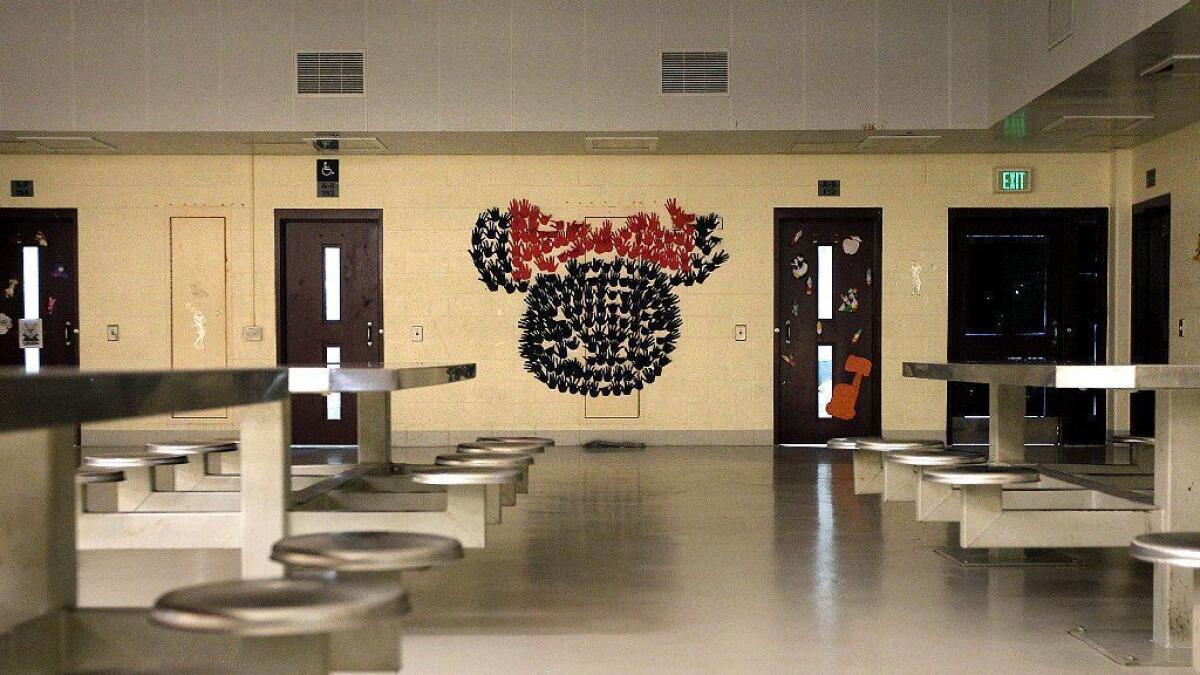L.A. County supervisors hope cameras will make juvenile halls safer. Officers are wary

In a damning report on the excessive use of pepper spray in Los Angeles County’s juvenile detention facilities, an internal watchdog in March made numerous recommendations to improve the department’s use-of-force policies.
One key idea: adding scores of closed-circuit video cameras to keep digital eyes on the youths held there — and on the overwhelmed officers charged with guarding them.
“Department facilities lack the necessary technology infrastructure to ensure that use-of-force incidents are captured on video,” wrote investigators with the county’s Office of Inspector General. “When videos of force incidents exist, they are difficult to access and view.”
The Board of Supervisors agreed with that assessment on Tuesday, unanimously approving a $7.4-million plan to install cameras and related technology at Central Juvenile Hall, the century-old facility in Boyle Heights that houses roughly 200 youths with pending court cases.
The plan is a step toward a more expensive long-term goal of improving camera networks across the department’s entire juvenile detention operation, the nation’s largest. The facilities have come under scrutiny in recent months amid reports of increasingly violent youths, and frustrated and demoralized detention officers.
The new cameras should help staff defuse tense situations in the housing units of Central Juvenile Hall, county officials said. They cited evidence that use-of-force incidents are more likely in areas not covered by cameras or where older cameras provide poor-quality images.
In addition to helping to monitor the population, department managers hopes the cameras will aid in reviewing incidents to ensure that staff follow the rules and to provide real-life examples for training.
The inspector general’s office found that the current network of cameras captured evidence of staff violating department policies, including of not using pepper spray as a tool of last resort to control unruly youths.
Rank-and-file officers, many of whom have complained in recent months about the increase in youth-on-staff assaults and a perceived lack of support by management after such incidents, generally approve of the idea of more cameras, but remain wary.
Hans Liang, president of the Federation of State, County and Municipal Employees Local 685, said the detention officers’ union believes it can improve monitoring and protect members’ safety.
But some members worry that the video could be unfairly used against them during use-of-force investigations — and that officers won’t be given the benefit of reviewing the footage to increase the accuracy of their reports detailing such incidents.
“It could be a good tool. There are a lot of our staff who have been assaulted by the youth in the halls, and that would help document those cases and have more clarity on them,” he said. “If it’s a fair and equitable review, that’s one thing. But if you’re only going to take camera angles 1, 5 and 6, but not camera angle 7, because it doesn’t support our case, those are things that we would be concerned about.”
In recommending increased camera coverage, the inspector general didn’t support allowing officers to use the images when writing their post-incident reports. But it said their supervisors should use the images to better assess the accuracy of those reports.
The plan is the latest move approved by the Board of Supervisors to address conditions inside the troubled detention facilities, which have caught the attention of monitors from the California Department of Justice. In April, six officers were charged with assault and child abuse over the use of pepper spray on a group of detainees.
The visit by state officials came a few days after a report in The Times documented widespread staff complaints about working conditions and damage done by youths to the Barry J. Nidorf Juvenile Hall in Sylmar, including gang graffiti, shattered windows and broken ceiling tiles.
The department has said it’s working to address staffing issues at the facility and allowed to The Times to tour Central Juvenile Hall in an effort to show that such damage isn’t common.
County officials showed off numerous housing units and common areas during a two-hour visit. Rooms, halls and common areas were clean and tidy, despite the facility’s age, with detainees calmly attending school, walking through recreation yards and interacting with staff.
Departmental data, however, continue to show widespread challenges with assaults by youth on one another and on staff.
Management, meanwhile, acknowledges a desire to do more to reduce gang-related tensions and meet a growing need for mental health services.
In addition to scores of new cameras, the county’s plan also calls for the installation of software, workstations and remote servers allowing supervisors at Central Juvenile Hall — and management in the department’s headquarters in Downey — to view the videos. The design and installation of the system is expected to take 21 months, county officials said.
More to Read
Start your day right
Sign up for Essential California for news, features and recommendations from the L.A. Times and beyond in your inbox six days a week.
You may occasionally receive promotional content from the Los Angeles Times.







